Every single F1 street circuit - from best to worst
The F1 world championship has raced at 27 different street circuits – we rate them all
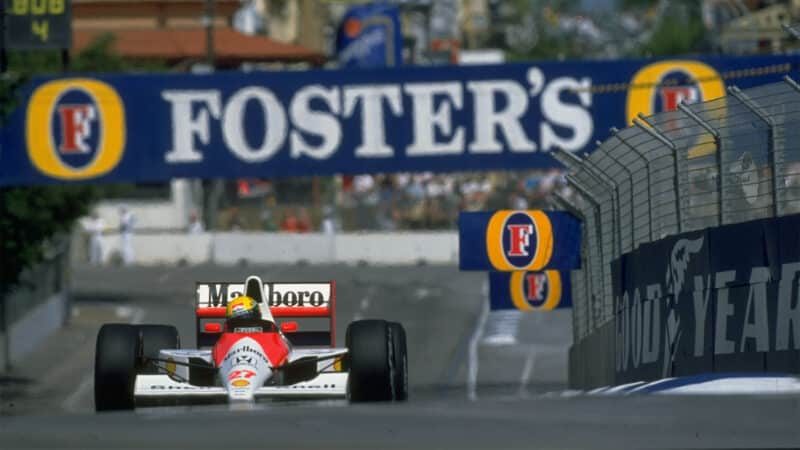
What is F1's greatest street circuit?
Getty Images
Formula 1 has always had a complicated relationship with street circuits.
They can provide unpredictability, and an unmistakable backdrop that permanent tracks often can’t match, but they also test patience with tight confines, processional racing, and an unforgiving lack of run-off.
From Monaco’s timeless prestige to the polarising spectacle of Las Vegas, the calendar now features more temporary tracks than at any point in F1 history, each with its own character, and its own flaws.
When the F1 championship came into being in 1950, race events were often held public roads due to a lack of permanent circuits.
While the number of street tracks has gone up and down through the decades, they are now very much in vogue again, due to their ‘green’ credentials as having a potentially smaller carbon footprint than a permanent track and being easier to sell to local authorities – if the event flops, the F1 apparatus can be removed without a trace.
So, with street circuits back in fashion, we run through every single one the world championship has visited since its 1950 inception – and rank them, naturally.
27. Caesars Palace, Las Vegas, USA
1981-1982
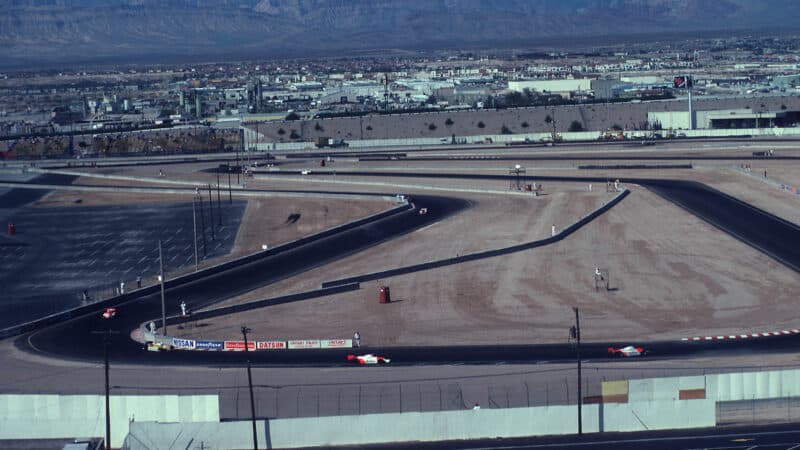
Vegas MkI: Not a classic
Where do we begin? With the worst street circuit of all time, naturally.
Admittedly the Caesars Palace race wasn’t actually run on a street per se, but it was held on one of the architectural cornerstones of American culture: a parking lot.
So, if people are parking their road cars there, it squeaks in as a street race.
Unsurprisingly, the 14-turn, 2.2-mile track was awful. Crossing vast acres of tarmac in front of the Caesars Palace casino in Las Vegas, the debut race in 1981 didn’t exactly inspire the F1 heroes of the day.
“It’s like a goat track, dragged down from the mountains and flattened out. What a bloody place to be ending your career…” said soon-to-be-retired Alan Jones.
“With no disrespect to the fine people at, er, Caesars, I think it is safe to say that their temporary circuit, running between featureless concrete barriers, presented minimal challenge and even less glamour,” wrote Motor Sport‘s Mike Doodson on his experience of the race.
Both the race and circuit were unpopular with drivers and spectators, lasting just two years.
26. Miami, USA
2022-present
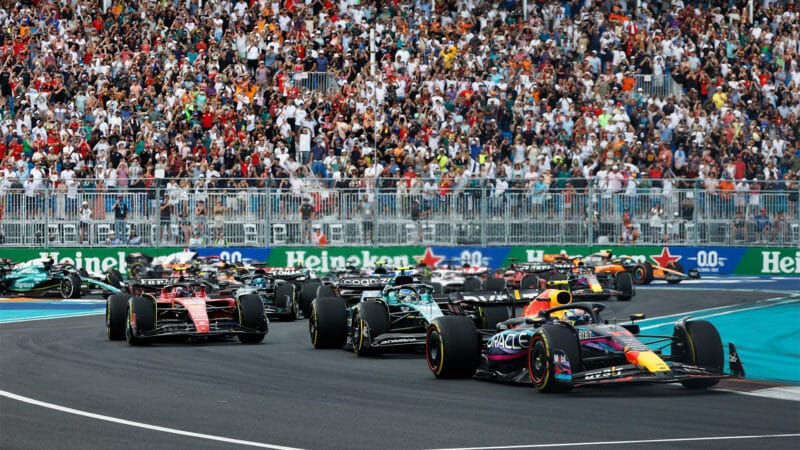
Miami has been another US flop (in racing terms)
Red Bull
It’s difficult to choose between Caesars Palace and Miami in the battle of the car parks, but at least the latter has had a few memorable moments.
Lando Norris’s breakthrough victory in 2024 was its high point, while Max Verstappen’s charge from third on the grid to win in 2022 showed that the track can at least serve up some variety.
The circuit itself, though, has never truly convinced.
From the start, it carried an ’80s F1 throwback vibe when the surface literally began to break up during practice in its debut year.
“Most importantly the circuit surface is a joke,” Sergio Pérez said after qualifying in 2022. “The racing is going to be difficult. You’re going to have drivers making mistakes because we’ve been put in this situation.”
The tarmac has since improved, but the layout has remained awkward, with overtaking dependent on DRS and little rhythm between its stop-start corners. For all the glitz around Hard Rock Stadium, the Miami GP has yet to win over the fans.
25. Dallas, USA
1984
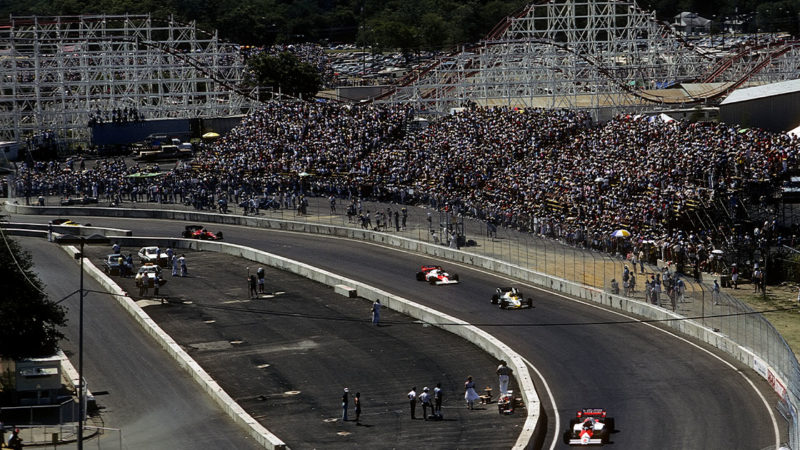
Dallas ’84: track surface revolted
Getty Images
“Of course there shouldn’t be races like this, out of the blue, but the fact is, we’re all whores, aren’t we? If the money’s right, we’ll turn up anywhere and do our stuff…” said Keke Rosberg of F1’s one and only Dallas GP, held in 1984.
“The only thing good about it, is that suddenly Detroit is not so bad…” added Alain Prost.
The Dallas course, an untested, rapid street track made up from backstreets in the Texan town, was held once only in the blistering summer heat of 1984 – as in the circuit literally blistered.
Temperatures went over 40C, the track surface began to lift, and drivers threatened to revolt and not race as officials desperately tried to quell both competitors and bubbling asphalt.
Once it got going, Rosberg would win an attritional affair, but money problems meant F1 would never do Dallas again.
24. Phoenix, USA
1989-1991
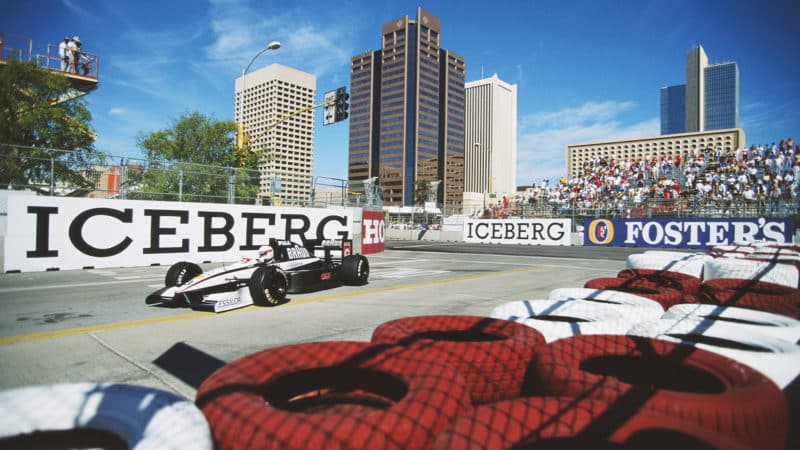
Phoenix was done for by the ostriches
Geographically, the American urban landscape doesn’t really go for nice corners or bends – it’s grid patterns or nothing.
So that’s why a quartet of US street efforts prop up this list, with Phoenix only making it ahead of the rest because it was slightly less awful.
The circuit featured no less than eight 90-degree turns – it’s no surprise that the nearby Chandler Ostrich Racing Festival consistently outdrew the F1 race for attendance.
“I remember going to Phoenix in my first season, and walking in the morning with my wife,” remembered Johnny Herbert. “We met a couple who were walking too. They asked, ‘what’s going on here?’
“We said, ‘we are here for the Grand Prix’. They said ‘we are here for the ostrich racing’”.
Crippling mid-summer heat meant only six cars out of 16 finished the first race, but the racing wasn’t actually that bad – as proved by Jean Alesi’s famous duel with Ayrton Senna in 1990 – but in the end the ostriches won out, poor attendance meaning the race was cancelled three years into a five-year deal.
23. Avus, Germany
1959
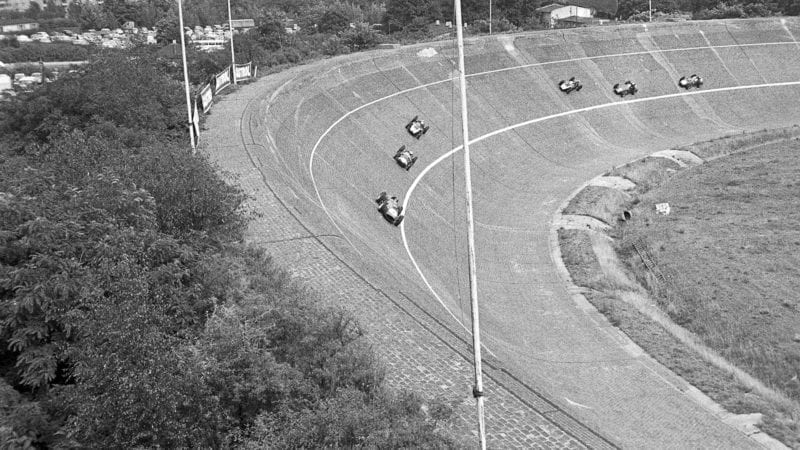
The Avus wall of death
Getty Images
Does Avus, with just two straights and two corners, have more personality than the above tracks? Possibly.
Running through the Grunewald forest, what is essentially an elongated loop of two ends of a dual carriageway was used for one championship grand prix in 1959.
The 12-mile layout featured a ‘Wall of Death’ turn at the North end, providing for some spectacular photography but also hair-raising racing moments.
Tony Brooks would win for Ferrari on the championship‘s sole visit, but the meeting was marred by the death of Jean Behra, who went over the banking during a sports car race.
22. Valencia, Spain
2008-2012
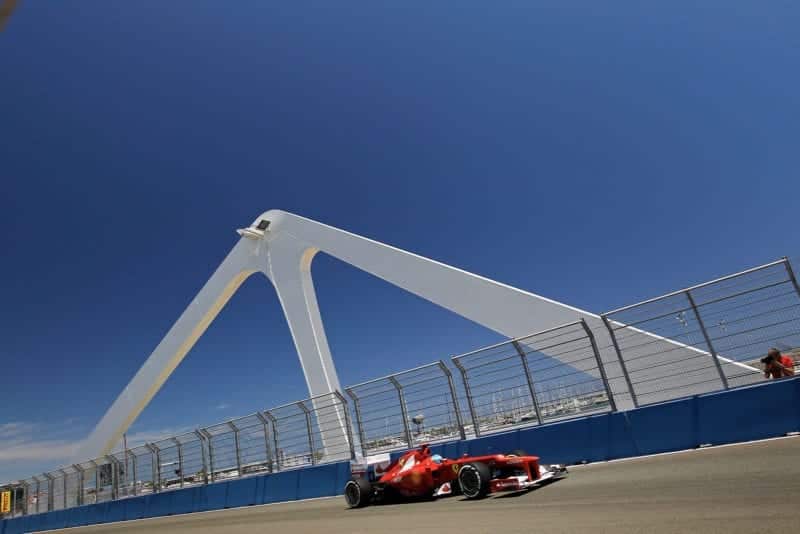
Alonso claimed final Valencia race
DPPI
Valencia’s street circuit threw up a couple of interesting results, but ultimately went unloved.
Held in the Spanish city’s dockland area, the event was created to capitalise on Fernando Alonso’s increasing popularity in his home country.
With Hermann Tilke imposing his vision onto the harbourside, the 5.419km-long (3.367 mile), 25-turn track featured a swing bridge crossover and… that was about it as far as interest goes.
Like many circuits that don’t get used very often, dust off-line meant it was difficult to overtake.
Felipe Massa won the first GP there from pole in 2008, before his compatriot Rubens Barrichello reinvigorated his 2009 title challenge by prevailing for Brawn the following year.
The circuit would play host to one classic in 2012, when Fernando Alonso stormed back from 12th to take an emotional win in front of his home crowd.
21. Boavista
1958 & 1960
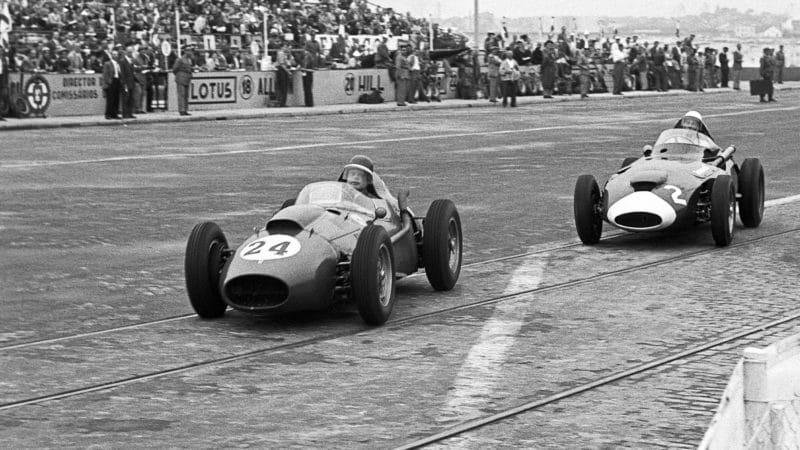
Hawthorn vs Moss at Boavista ’58
Bernard Cahier/Getty Images
Boavista, or Oporto, held the Portuguese GP twice in 1958 and 1960.
The lap began opposite the harbour on Esplanada do Rio de Janeiro and continued to Avenida da Boavista before winding through Portuguese back streets and returning to the harbour.
The first two corners were part of an awkward double roundabout section, somewhat of a precursor to the doomed Birmingham Superprix 30 years later, featuring tramlines to cross and cobbles to negotiate.
Stirling Moss dominated the first race in ’58 to win by 5min 13sec, but also managed to scupper his own title hopes by giving evidence to support Mike Hawthorn, who had initially been disqualified for reversing back onto the track after an off – the latter would become ’58 champion due to the points he garnered in Portugal.
Jack Brabham would win the next time the world visited the circuit in 1960 before it was excluded due to safety concerns.
Not terrible, but no classic.
20. Monsanto, Portugal
1959
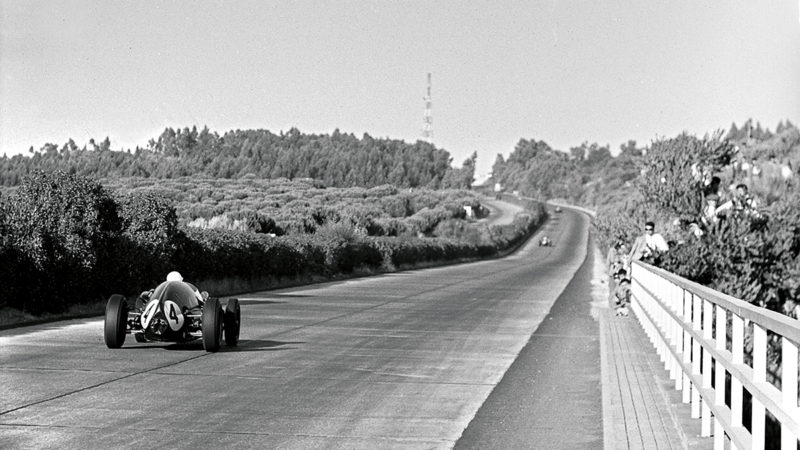
Moss on his way to victory in 1959 at Monsanto Park’s only world championship grand prix
Sandwiched in between the two Boavista races was Monsanto, a parkland blast which, like its Portuguese sister circuit, featured a fairly diverse range of surfaces (more tramlines).
The main straight was ironically the road to future GP venue Estoril, the rest of the track winding through the Lisbon hills, not dissimilar to Montjuïc Park.
“The whole nature of the circuit is one of pure road racing with nothing in the way of banked corners or wide open spaces to make things easy for the drivers; in fact, just the opposite, with tricky cambers, braking to be done on curves, blind corners, tree-lined sections and all the normal difficulties met with in everyday motoring,” wrote Denis Jenkinson in his ’59 race report.
However, after just one visit F1 never returned to the Mediterranean venue.
19. Ain-Diab, Morocco
1958
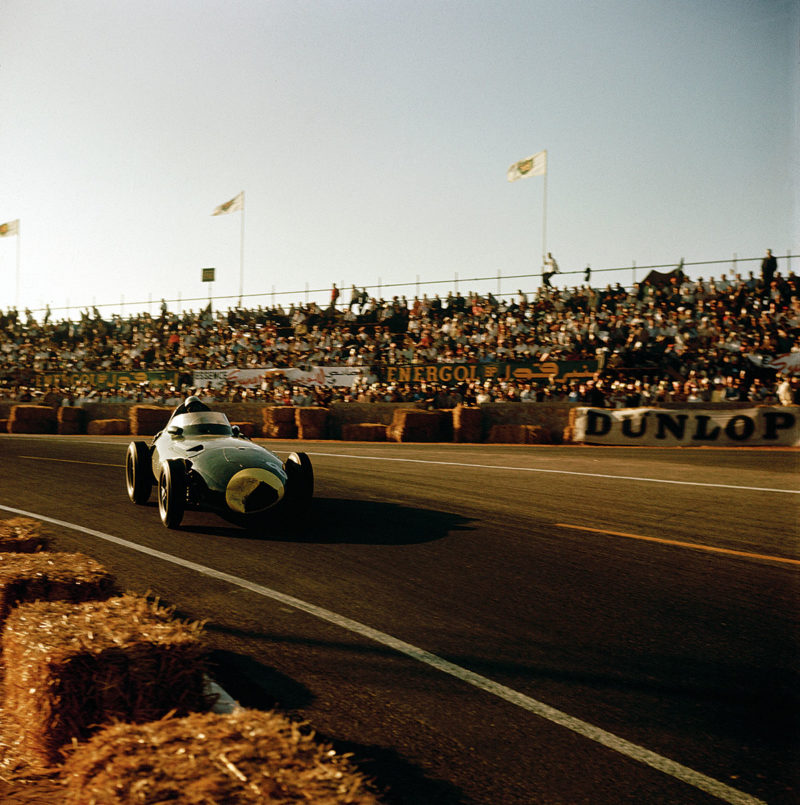
Moss races through the Moroccan desert
The 7.603km (4.724 mile) Ain-Diab circuit was a rapid Moroccan track built on the coastal road which ran through the Sidi Abderhaman Forest, the main desert route from Casablanca to Azemmour and the local suburbs.
Its one and only world championship race played host to the title showdown between Mike Hawthorn and Stirling Moss set-up by the latter’s sportsmanship in Boavista, mentioned above.
Moss would win out on the day, but Hawthorn had enough points margin to become the first British F1 champion.
The circuit (like many of its day) was dangerous, and the race was marred by the death of Moss’s Vanwall team-mate Stuart Lewis-Evans, from burns sustained in a crash when his engine seized.
18. East London / Prince George, South Africa
1962-1963, 1965
Though not F1’s first foray on the continent, South Africa came to represent grand prix racing’s on-and-off home in Africa for decades.
The original pre-war Prince George circuit in East London was over 15 miles long, the F1 version was shortened to 2.4 miles.
A simple circuit with only eight turns, it ran alongside the coast on closed public roads before looping inland,
It lasted three rounds (1962, ’63 and ’65), the first of which was won by Graham Hill before Jim Clark took a brace, but the circuit was eventually deemed too narrow for F1 cars, prompting a move to Kyalami for 1967.
17. Las Vegas, USA
2023
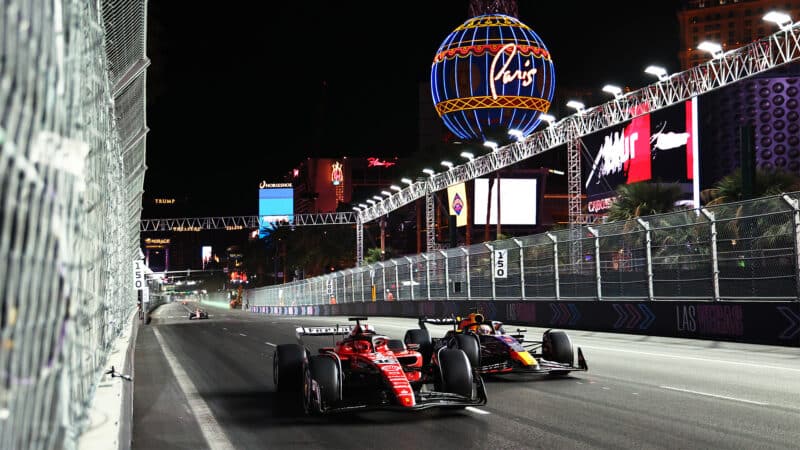
Vegas is F1’s latest spectacle
Red Bull
F1’s new Nevada circuit, which runs down the Las Vegas Strip, features the dazzling sphere and sees drivers at full throttle for much of the lap, is certainly spectacular.
But is it actually a great track? The jury’s still out on that one.
All new modern circuits, even street offerings, suffer a lack of personality due to safety-necessitated wide tracks and high barriers – they largely look the same.
To be fair to the new Vegas track though, it produced a reasonable debut race in 2023, with Charles Leclerc almost holding out in Sin City against the ultimately irresistible force of Max Verstappen.
The weekend, welcomed amidst much fanfare with a pop star-laden opening ceremony, was held through a series of late-night sessions to please as many time zones as possible.
Since then, however, the shine has dulled. The novelty of late-night sessions and Strip backdrops hasn’t masked the fact that the circuit tends to produce formulaic racing, heavily reliant on DRS zones.
The 2024 edition was competent enough but hardly classics, leaving Las Vegas stuck between spectacle and substance – glitzy, marketable, but not yet a must-watch.
16. Pedralbes, Spain
1951, 1954
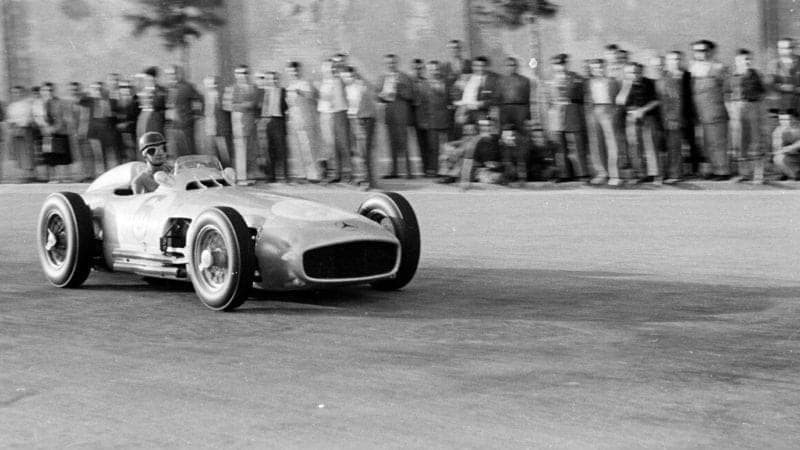
Hans Herrmann ponders track limits at Pedralbes
Getty Images
Madrid is set to host its first world championship street race in 2026, but it quite likely won’t be as thrilling as Pedralbes.
Held on the streets of suburban Barcelona, the circuit first hosted F1 in 1951, where Juan Manuel Fangio won and secured his first world title.
The start-finish straight rushed down Avenida del Generalísimo Francisco Franco – now Avinguda Diagonal – before a hairpin brought it on an uphill rise towards a series of quick, open corners which encourage overtaking.
However, the Spanish GP would be held here just once more in 1954, when Mike Hawthorn took his second F1 win.
15. Detroit, USA
1982-1988
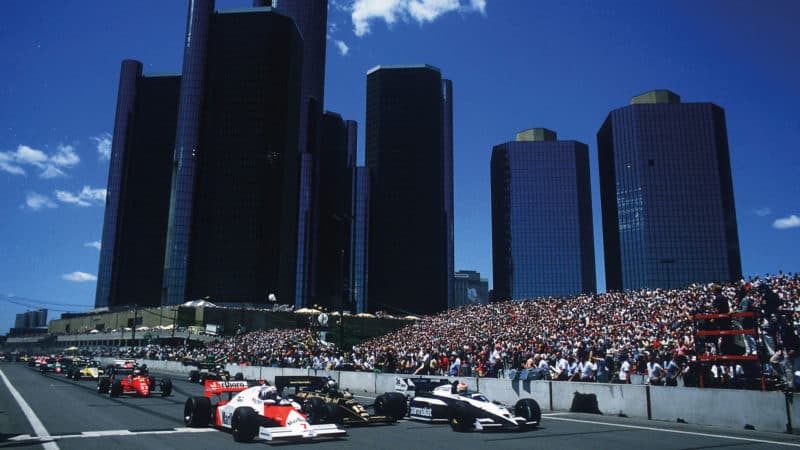
Pedal to metal in Motor City
Detroit was never in danger of touching the top ten in this list, but Motor City did play host to some significant F1 moments.
John Watson put in one of the greatest drives ever seen to come from 17th and win a landmark 1982 race in a season packed with excitement, drama and tragedy.
Michele Alboreto secured Tyrrell’s final victory the following season (though the team would soldier on for another 15 years) before street circuit specialist Ayrton Senna won three on the bounce from ’86-’88.
“Just accept the fact that a Grand Prix race was held through the streets of America’s Motor City and accept the fact that it was a lot of fun,” wrote Denis Jenkinson of Detroit’s inaugural race weekend.
“A bit wild and woolly at times and a bit chaotic, but you must expect that if you race through the streets of a city, and what a nice change from plastic autodrome racing and ‘clinical facilities’.
“There was nothing clinical about the Detroit circuit or the pits but in view of the temporary nature of the whole thing it was all adequate and a triumph for the Detroit Renaissance Grand Prix Inc.”
14. Marina Bay, Singapore
2008-present
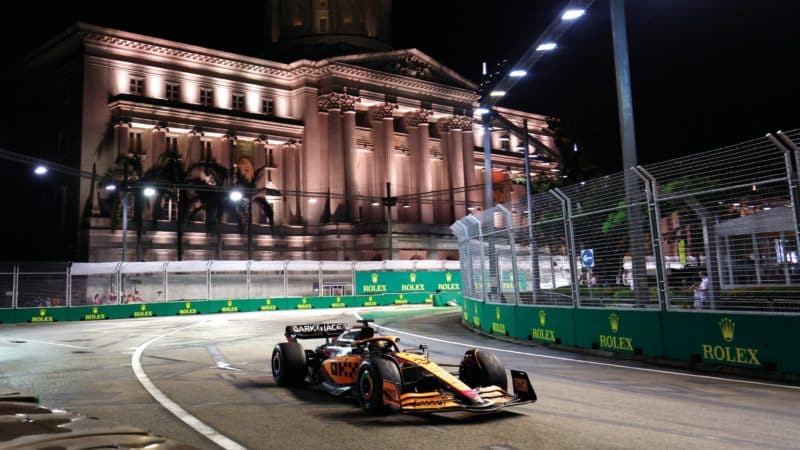
Singapore often brings drama under the lights
Getty Images
Like Detroit, it can be difficult to put forward an argument that Singapore is emphatically a great race track, but it has been witness to even more seismic moments than its American counterpart.
The three-mile, 19-turn Marina Bay circuit is a bit of a headache for drivers and fans, but such is its technical nature that cars often come together in dramatic fashion.
Crashgate famously unfolded on the humid Singapore streets – which was also F1’s first ever night race – and one of the most spectacular first lap crashes ever seen ensued in 2017 when Sebastian Vettel, Max Verstappen and Kimi Räikkönen all managed to collide before they’d even reached Turn 1, handing the championship initiative to Lewis Hamilton.
The British star produced one of the all-time great pole laps in 2018, while the following year Vettel took his final ever F1 win at the wheel of a Ferrari.
2023 was witness to Red Bull finally losing its stranglehold on the F1 season as a thrilling battle broke out between Carlos Sainz, Lando Norris, George Russell and Hamilton; the Spaniard just hanging on for the win.
The 2024 edition was dominated by Norris, who led every lap to take a commanding victory in a pretty straightforward race.
Despite its challenges — high humidity, tight corners, and relentless night-time demands — Marina Bay continues to provide spectacle and drama, even if its layout is unforgiving and rarely yields easy racing.
13. Bremgarten, Switzerland
1950 – 1954
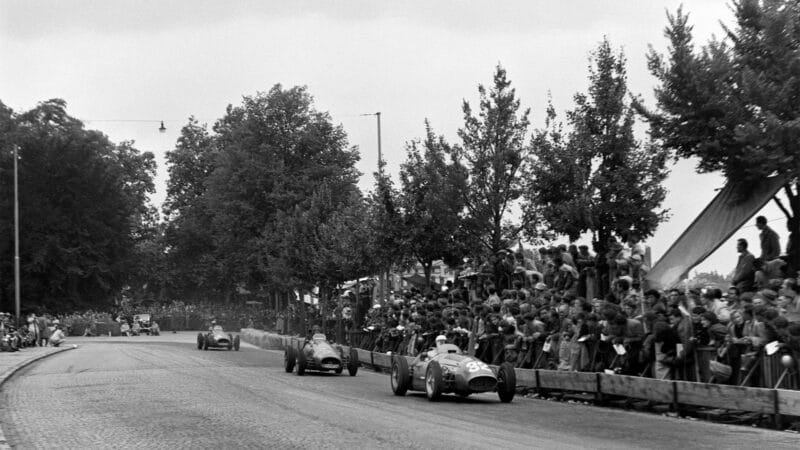
Bremgarten: an early, and very dangerous, F1 street circuit
Before the 1955 Le Mans disaster, Swiss street circuit Bremgarten was a mainstay of the F1 calendar for five years.
A track as thrilling as it was dangerous, 4.5-mile Bremgarten had no real straight, was lined with trees and often suffered from poor light – and that’s without considering the rain. The track would stay wet long after a downpour had stopped, as water continued to cascade from the foliage.
Giuseppe Farina won the first championship Swiss GP in 1950, while Fangio claimed its last, proving his dominance and winning for Mercedes by over a minute.
That masterclass from El Maestro proved to be Bremgarten’s swansong, as Switzerland banned most motor racing in the wake of the tragedy at Le Mans. Would such a circuit have lasted much longer anyway?
12. Pescara, Italy
1957
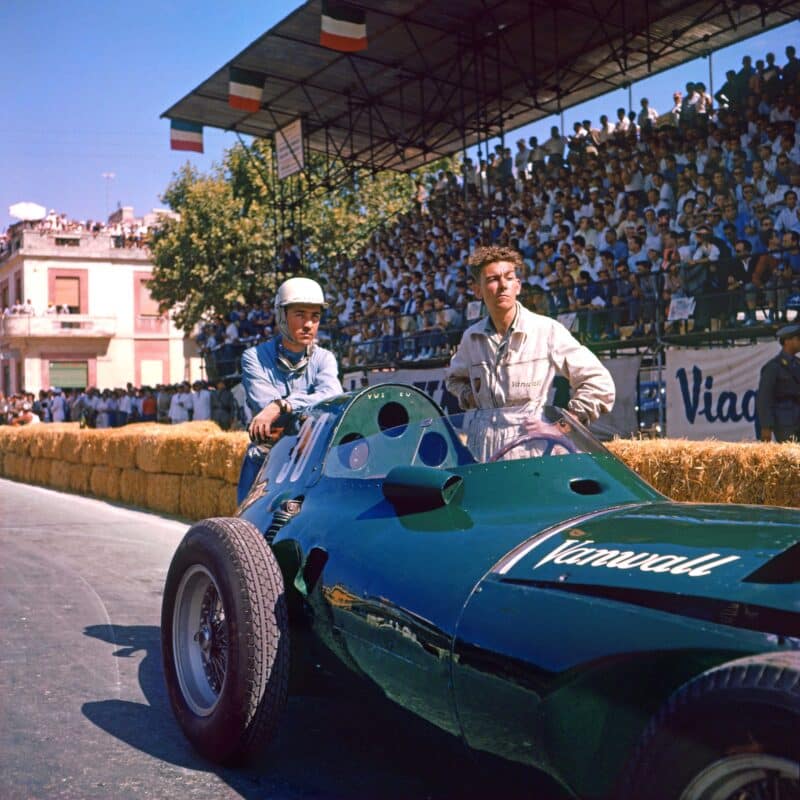
Lewis-Evans prepares for blast-off at 1957 Pescara GP
Grand Prix Photo
Pescara was a pre-war circuit deemed largely too dangerous even then, but was brought into the fold for a single world championship appearance in 1957.
The hair-raising Abruzzo blast is still the longest track to ever be seen in the world championship at 25.8km (16 miles), with not one but two 5.5km (3.4 mile) straights, the first of which ran down the coast before heading up into the mountains. The track’s highest point was an incredible 185m (607ft) above sea level.
The Coppa Acerbo race was run there during pre-war years, with young ace Guy Moll killed there during the 1934 edition.
Pescara made its world championship bow in 1957 due to the last-minute cancellation of the Dutch and Belgian GPs. It took Stirling Moss, second off the line in the beautiful Vanwall, just over one 10min lap to get past Ferrari’s Luigi Musso, winning by over 3min from Juan Manuel Fangio in one of his greatest drives.
Such was the circuit’s vast size, organisers didn’t even attempt to charge most of the 200,000 people in attendance.
11. Reims, France
11 GPs between 1950-1966
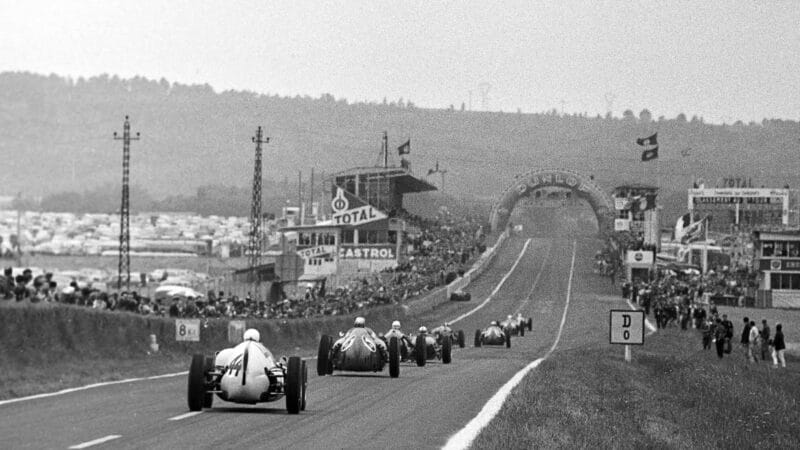
Reims main defining personality trait – or straight, rather
Getty Images
Hardly the most, err, technical track, but the scene of many a classic.
Triangular Reims, mainly comprised of three long straights, represents the ultimate high-speed rumble.
Its 1950s-period grandstand and pits – standing alone in French farmers fields – made it one of the iconic circuits of the world championship’s nascent years.
It says something for the track that despite its lack of many defining characteristics, its pair of 2.2km (1.25-mile) straights produced a few slipstreaming thrillers.
In 1953 Mike Hawthorn emerged from a titanic battle with Juan Manuel Fangio to take his first F1 win, while Fangio himself would lead home a famous 1-2 for Mercedes on the Silver Arrows’ return to grand prix racing the following year.
F1 last visited in 1966 and the circuit closed in 1972, but the period bit and grandstand buildings still stand as a poignant reminder of racing’s ‘golden age’.
10. Baku
2016-present
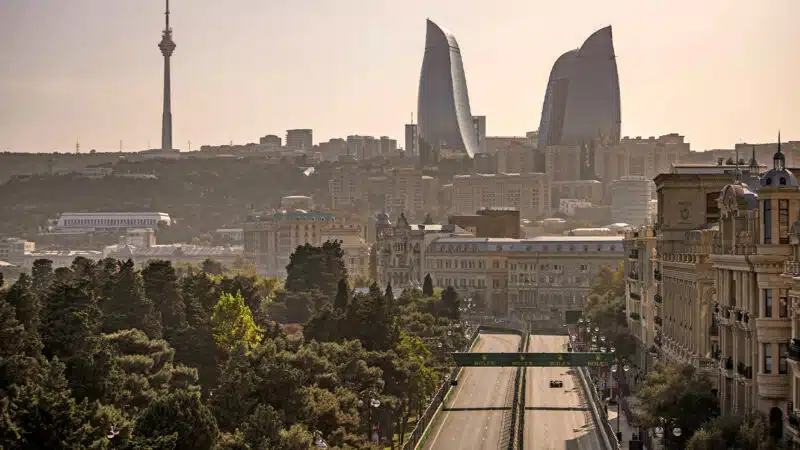
Baku: beautiful and dramatic
Grand Prix Photo
Held in a far-flung corner of Europe with little motor sport heritage, Azerbaijan’s Baku grand prix circuit struggled to get pulses racing when it was first announced for 2016.
Since then though, it has become a track which has for the most part has guaranteed action, its pronounced different sections pushing drivers and their cars to the limit.
Coming off F1’s longest ‘straight’ (the 2.2km/1.37 mile stretch winds left and right before truly becoming straight), the circuit runs through a series of 90-degree corners connecting a few more long straights which run down the city’s leafy boulevards before drivers have to thread through the medieval town section.
If they’ve managed to come though that unscathed, then drivers plunge back towards the huge start-finish straight.
Slipstreaming mishaps, overenthusiastic dicing through the 90-degree section and brushes with the barrier later on in the lap mean collisions and crashes are always likely, as shown by dramatic races in 2017, 2021 and 2024.
For some, the track has become a modern classic.
9. Jeddah, Saudi Arabia
2021-present
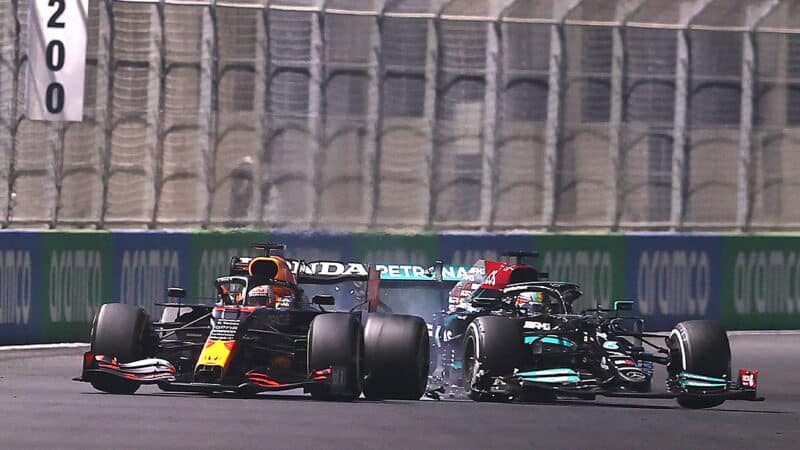
Saudi Arabia: scene of Verstappen and Hamilton’s famous clash
Lars Baron/Getty Images via Red Bull
Like Baku, Jeddah was largely derided before it arrived on the calendar in 2021.
In its four races, however, it has provided plenty of fast-paced thrills. Its 157mph average speed makes it F1’s second-fastest circuit after Monza. And the walls are much closer than at the historic Italian venue.
Lewis Hamilton and Max Verstappen famously squabbled throughout 2021, the former prevailing after tripping over the latter, and in 2022 Leclerc also battled with the Dutchman in a highly entertaining race.
The close barriers and plenty of blind corners mean danger is never far away, Mick Schumacher proving the point by breaking his Haas in two during 2022 qualifying.
Despite this though, drivers love it – a true challenge in an anodised age.
8. Long Beach, USA
1975-1983
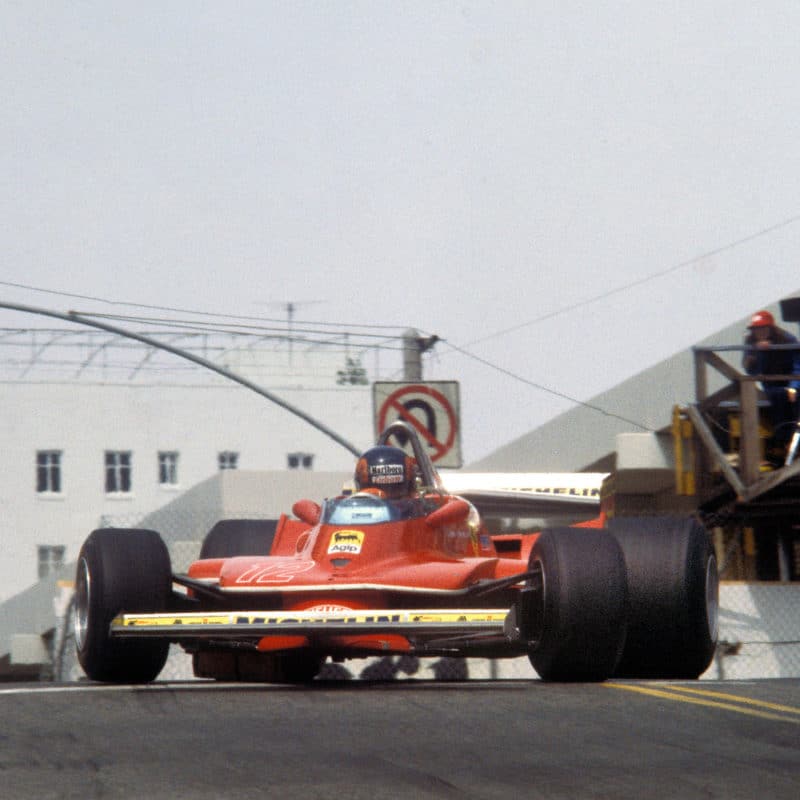
Gilles Villeneuve gets sideways at Long Beach
Grand Prix Photo
Probably better than all the other US street circuits combined – and there are a lot of them – Long Beach became an instant classic on its introduction in 1976.
On a relatively simple 13-turn layout, the cars blasted down Ocean Boulevard before winding their way through through Long Beach’s slightly seedy side streets and up two steep inclines, with the Queen Mary liner looming over proceedings.
As Preston Lerner explained for Motor Sport, the track represented something different for street racing – a departure from tearing through the countryside or sliding on cobbles round narrow European streets.
“Long Beach, not Monaco, is the venue that established the template for the modern street race,” he said.
“It was Long Beach that served as the proof of a concept that’s now considered commonplace – nestling a temporary circuit within a city centre and focusing not merely on a single headline race, no matter how exalted, but on providing a full-service motor sport bazaar.”
There were no repeat winners during its eight-year tenancy, but Niki Lauda claimed the first victory of his McLaren comeback on the west coast, and John Watson set an F1 record by coming from 22nd on the grid to win at its final running in 1983.
7. Spa-Francorchamps
57 GPs between 1950-present
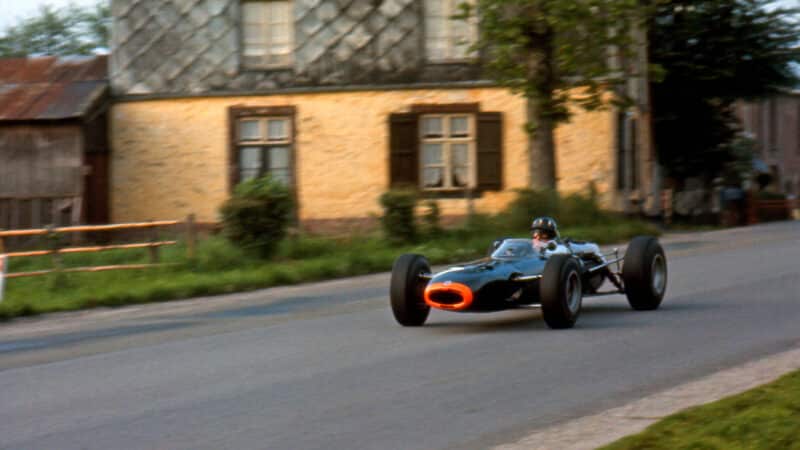
Graham Hill goes round the house at the ‘old’ Spa in 1965
It is now not often thought of a street circuit, but that’s how Spa-Francorchamps started in its original configuration in 1921
Using public roads from the La Source hairpin, the original circuit moved through the familiar Eau Rouge-Raidillon-Kemmel straight section before bypassing what is now the Les Combes chicanes and turning left a Malmedy, heading the Masta straight and its infamous kink.
The entire lap nine-mile lap rushed past houses, telegraph poles, stone walls and plenty of other highly dangerous street furniture, and was little changed when it hosted a round of the inaugural world championship in 1950.
Though forging a reputation early on as one of the ultimate drivers’ tracks, some came to detest it – most notably Jim Clark, despite winning the event five times.
In its new, shorter configuration, introduced in 1979, some of the track was still used for public roads until 2000 – including the Bus Stop chicane. Wasn’t just a name, you know.
The formidable track has claimed many victims, including pre-war British Mercedes hero Dick Seaman. Chris Bristow and Alan Stacey both died during the 1960 race, the mercurial Stefan Bellof was killed in 1985 and more recently Formula 2 driver Antoine Hubert was killed in 2019. Dilano van’t Hoff lost his life in a 2023 Formula Regional race.
6. Rouen, France
5 GPs between 1952-1968
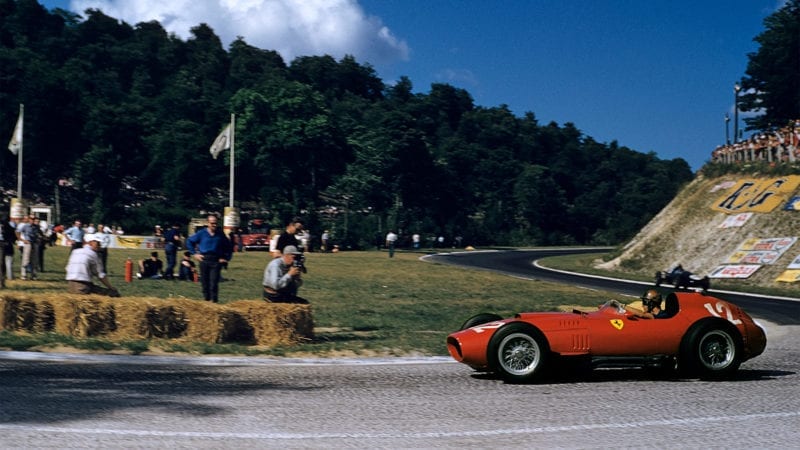
Collins at Rouen-Les-Essarts for the ’57 French GP
Bernard Cahier/Getty Images
“Rouen may be neither the greatest nor best remembered of tracks, but it placed demands on the courage and skills of its drivers that few tracks, if any, could emulate,” wrote Andrew Frankel when visiting the old circuit.
“The late Denny Hulme, a man as brave as they came, was to recall standing in the pits, as the cars swept past the pits during practice. ‘Jeez, that was fast. We used to listen to the Formula 1 guns going down there to see if they could hold it flat down the hill.’”
The French circuit was a staple of F1 in the 1950s and ‘60s. Running at just under 3.5miles in its most-used configuration, cars would blast down steep public roads heading into a tricky cobbled hairpin, before returning uphill through the woods.
However, like many semi-street circuits of its day, the track was inherently dangerous. Several drivers lost their lives, perhaps most famously Jo Schlesser, whose magnesium-bodied Honda was instantly engulfed in a fatal fire following a crash during the 1968 French GP. The track closed in 1973.
5. Albert Park, Australia
1996-present
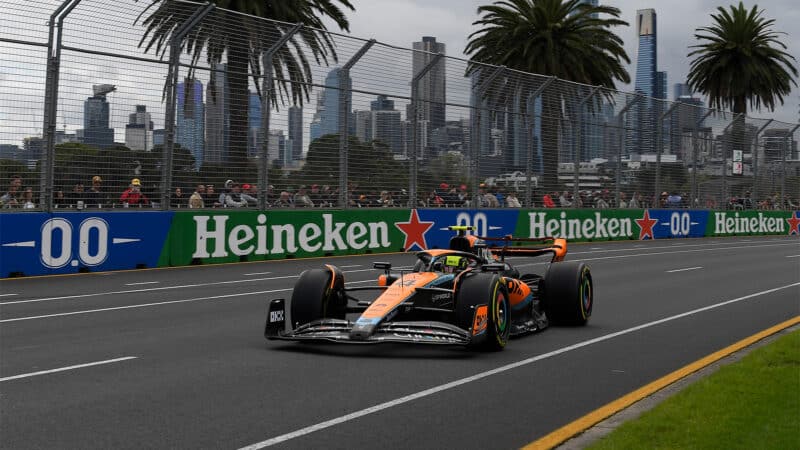
Melbourne – F1’s Australian home for nearly 20 years
Grand Prix Photo
Albert Park returns as the season opener next year, and for many it’s the rightful track with which to kick off each F1 season.
An unorthodox 3.2-mile circuit which loops around a parkland lake, its unusual nature plays into the disorientation that usually accompanies the dawn of a new GP campaign, with new drivers, liveries and sometimes even teams.
Reigning IndyCar champion Jacques Villeneuve nearly won on his debut after fighting with Williams team-mate Damon Hill at the first race in 1996. Eddie Irvine claimed his first race win there in 1999 as did Giancarlo Fisichella in 2005.
Lewis Hamilton stunned the world by driving round the outside of Fernando Alonso on his debut in 2007 and two years later Brawn dropped an even bigger bombshell by rising from the ashes of Honda to take a 1-2 first time out.
The Turn 9 chicane was removed in 2022 to create a more flowing layout, but Albert Park was already pretty fast for a street circuit, meaning mistakes can be punished. The result is usually a thriller Down Under.
4. Monte Carlo, Monaco
1950-present
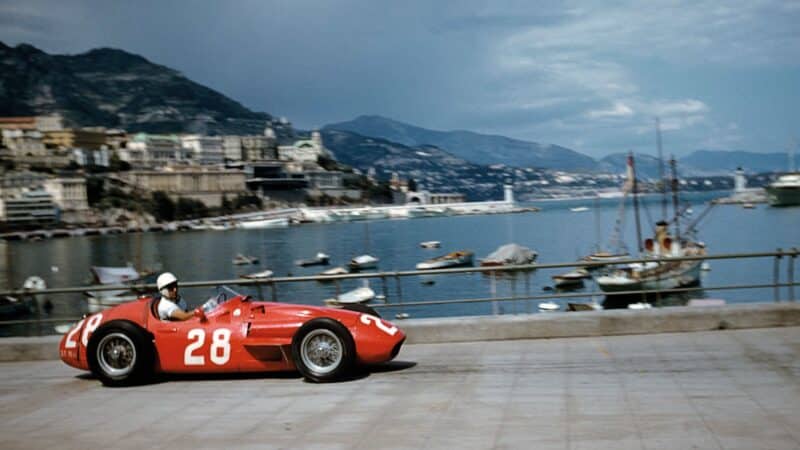
Monaco has always posed a unique challenge
Getty Images
Monaco isn’t the greatest street circuit of all time, but it is up there.
Snaking through the tight Principality streets and taking in all the sights on offer while it does so, it’s everything the town offers that makes it F1’s most memorable venue.
Incorporating fast cars in a glamorous location, lined with gambling palaces and billionaire deal-makers on yachts surrounded by helpers and hangers-on – the good, bad, terrible and even worse of grand prix racing’s make-up.
Such is the technicality of Monaco that those who triumphed there were long seen as masters of grand prix racing itself – with Ayrton Senna being the most obvious example, his six wins standing as the record.
Saint Devote, Rascasse, Loews Hairpin were bywords for grand prix greatness.
Now though, the driver that just gets to the front in qualifying usually wins.
Lumbering modern machines render the contest slightly pointless in 2024 – but it isn’t the track’s fault.
3. Montjuic Park
4 GPs between 1969 to 1975
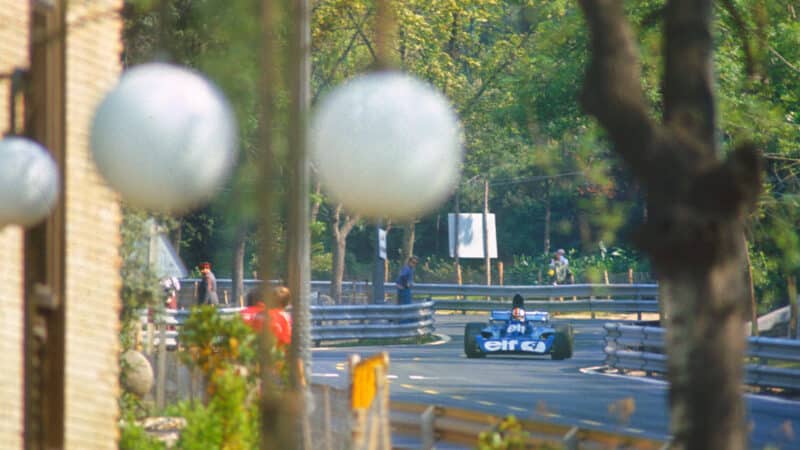
Tyrrell of Francois Cevert negotiates Montjuïc Park
Declared by former Motor Sport F1 editor Nigel Roebuck as “The greatest street circuit I ever saw,” for some drivers Montjuic Park came to represent paradise lost – for others it was hell on scorched earth.
“For sheer drama, in my opinion nothing has ever been the equal of the first part of the lap at Barcelona’s Montjuïc Park,” he wrote.
A parkland race track overlooking Barcelona with a layout which rose, plunged then rose again was as formidable as it was beautiful.
The track had a greater diversity of corners than Monaco, but was also faster.
Unfortunately, even by the standards of the day, the track was extremely dangerous – not helped by the fact that the installation of barriers was lax at best.
Things came to a head in 1975 when drivers threatened to revolt and teams set their own mechanics on securing the lacklustre barriers, some of which could be pushed over by hand.
During the race leader Rolf Stommelen’s rear wing failed, sending him over the barrier and killing four marshals. F1 would never race at Montjuic again.
2. Clermont-Ferrand
4 GPs between 1964-1972
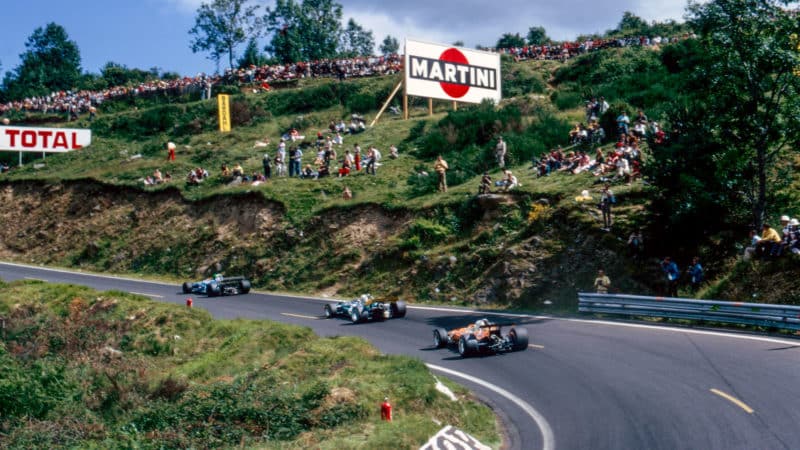
The mountainous surroundings of Clermont-Ferrand
DPPI
“It was the best track in France; better by far than everywhere else we went like Rouen, Reims and Paul Ricard,” so said Jackie Stewart.
The circuit he’s talking about is Clermont Ferrand – only at number two due to the fact it perhaps isn’t quite street circuit-y enough – stunning as it was.
Set around a dormant volcanic mountain overlooking the central France city, the cliffside dash was as much as a challenge for the drivers as it was pleasing to the spectator eye.
Such was the elevation that Denny Hulme recalled “A lot of people used to wear open-faced helmets there so they could throw up as they went down the hills…” while Jochen Rindt suffered from dizziness and double-vision, such were the g-forces involved.
Chris Amon – probably the greatest driver never to win an F1 race – put in his best performance there, dominating the GP before fighting back from a puncture to finish third.
Unfortunately the track struggled to attract much of a gate, and held its last championship race in 1972.
1. Adelaide, Australia
1985-1995
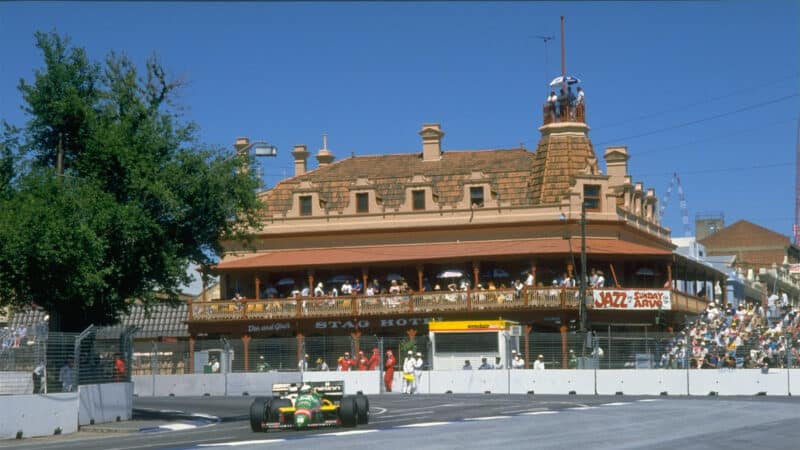
Adelaide had a special place in the heart of drivers and fans
“One of Australia’s greatest tourist attractions. Perhaps the most civilised, elegant little cities in the southern hemisphere. A pretty, gentle place on the human scale, offering year-round peace, quiet, refined wines and nothing noisier than a koala belching after an excess of gum-tips.”
Above is Clive James describing Adelaide, the F1 street circuit that has it all.
An exotic location with an attractive setting for the race itself, as well as a combination of close barriers, bumpy streets and also some high-speed blasts through leafy boulevards made Adelaide stand out.
Every street race should have a party atmosphere, and Adelaide had it and then some.
Running down Victoria Park the pit straight headed straight into the tricky – yet entertaining for spectators – chicane, followed by a series of right-handers, eventually reaching the kinked Dequetteville straight, followed by the final Racecourse section.
It was on the Dequetteville section that Nigel Mansell famously – or “colossally”, rather – had the puncture which lost him the ’86 world title, and on which Mika Häkkinen had his near-fatal accident in 1995.
Adealide also witnessed the ailing Benetton of Michael Schumacher spear into Damon Hill so as to stop him claiming the ’94 championship – Adelaide was always high on drama, F1 simultaneously at its worst and best.
It was one of the track’s characteristic high kerbs which launched Häkkinen into the barriers, but this was part of its challenge.
Adelaide was laidback: brilliant, beautiful and terrifying in its understatement. It hosted what truly was F1’s greatest street circuit.
